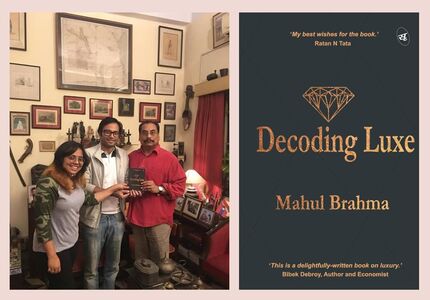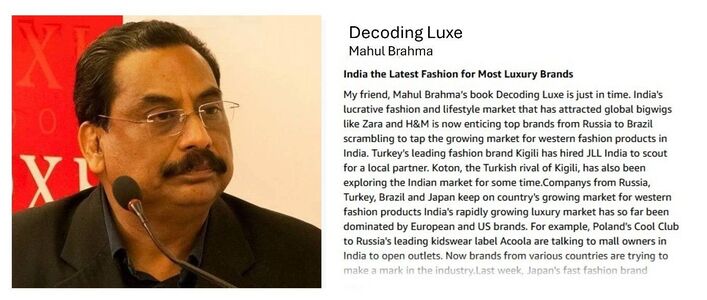My friend, Mahul Brahma’s book Decoding Luxe is just in time. India's lucrative fashion and lifestyle market that has attracted global bigwigs like Zara and H&M is now enticing top brands from Russia to Brazil scrambling to tap the growing market for western fashion products in India. Turkey's leading fashion brand Kiğılı has hired JLL India to scout for a local partner. Koton, the Turkish rival of Kiğılı, has also been exploring the Indian market for some time. Companies from Russia, Turkey, Brazil and Japan keep on India's rapidly growing luxury market, which has so far been dominated by European and US brands. For example, Poland's Cool Club to Russia's leading kidswear label Acoola are talking to mall owners in India to open outlets.
Now brands from various countries are trying to make a mark in the industry. Last week, Japan's fast fashion brand Miniso made its India debut at Ambience Mall in Vasant Kunj, Delhi. Many other Japanese luxury brands, including their top fashion retailer Uniqlo, are preparing to enter India, various people familiar with the developments said. Similarly, a host of other brands from the Land of the Rising Sun, including Mark Styler that owns fashion and luxury brands such as Mercuryduo, Dazzlin and Emoda, are scouting for local partners, industry sources said. There is a healthy appetite for luxury brands in India.
However, it is also an extremely competitive market and gaining a foothold here can be a challenge. Zara entered India in 2010 and is still a rage while its global rival H&M is making heavy inroads into the country's fashion market. Tommy Hilfiger, Aeropostale and Mango are among various other brands jostling in the space.
Exploring the elements that constitute the perceived luxuriousness of a brand, this book addresses the changing definitions of the term ‘luxury’ in today’s world. Taking the approach that the concept of luxury evolves from the consumer, the author introduces us to several luxury products as model to explains how the consumer interprets the luxuriousness of a brand.
This innovative study analyses the key elements that influence luxury branding, such as extended product, perceived uniqueness, authenticity and context specificity. By critically reflecting on the existing definitions of luxury and its challenges, this book makes a unique contribution to research and an essential read for marketing students and scholars.
Luxury is a state of wealth and comfort, often through the ownership and enjoyment of things that are expensive and unnecessary for survival The field of luxury studies increasingly encompasses a variety of perspectives not just limited to marketing and brand management.
In recent times, a host of novel and topical issues on luxury such as sustainability, counterfeiting, emulation and consumption trends have gained prominence which draw on the fields of in his first book dedicated to this complex issue. Including multiple perspectives. Whilst being very much grounded in reality, its aim is to offer an integrated picture of the environment in which luxury operates. It explores the newer debates relating to luxury consumption such as the signals used in expressing luxury, the socially divisive nature of luxury and the socio-economic segmentation that it brings. Filling a significant gap in our knowledge of this field.
The book will help readers comprehend the significant management challenges unique to this construct.


